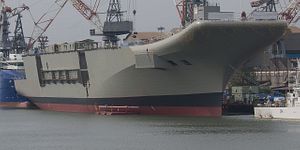According to remarks by a senior U.S. Department of Defense official, the United States would not oppose Indian purchases of advanced U.S. aircraft carrier technology. Frank Kendall, under secretary of defense for acquisition, technology, and logistics, told Reuters that the U.S. government would support an Indian purchase of an electromagnetic launching system for aircraft carriers, specifically San Diego-based General Atomics’ Electromagnetic Aircraft Launch System (EMALS).
“I’m optimistic about cooperating with them on that,” Kendall told Reuters when asked about supporting a possible Indian EMALS deal. “They’re going to have to make their own decision about what technology they want, but I don’t see any fundamental obstacles to them acquiring some of our carrier technologies, if they want them,” he added.
India currently operates two aircraft carriers, the INS Viraat and the INS Vikramaditya. The former is a Centaur-class carrier, purchased from the United Kingdom, and the latter is a modified Kiev-class carrier, purchased from Russia and in service in 2013. India is currently constructing an indigenous carrier design, the INS Vikrant, a 40,000 ton carrier expected to enter service in 2017. A second Vikrant-class carrier, the INS Vishal, is planned and expected to enter service before 2030.
The Vikrant-class carriers will use a ski-jump assisted Short Take-Off But Arrested Recovery (STOBAR) launch system for jets aboard the carrier. Only Russian, India, and Chinese carriers use this system for their carriers. Adopting EMALS would entail a switch to the more complex Catapult-Assisted Take-Off But Arrested Recovery (CATOBAR) launch system. EMALS refines the U.S. Navy’s existing CATOBAR launch systems by imposing less stress on aircraft chassis. In general, CATOBAR launch system impose fewer design constraints on carrier-based aircraft than STOBAR systems.
General Electronics describes the advantages of EMALS over conventional launch methods as follows:
- Reduced manning workload
- Reduced thermal signature
- Increased launch availability
- Reduced topside weight
- Reduced installed volume
- Launch capability for unmanned aerial vehicle
In operational terms, Indian carriers equipped with EMALS would enjoy greater flexibility in carrier operations over their competitors in the region. Though costlier, a successful implementation of EMALS would theoretically allow Indian carriers to operate a wider range of aircraft and deploy them with more ease. China’s Liaoning, for example, is a STOBAR carrier — a constraint that led the U.S. Department of Defense to estimate that Chinese J-15 fighters taking off from the carrier would be “limited in range and armament when operating from the carrier, due to limits imposed by the ski-jump takeoff and arrested carrier landings.”
Kendall’s comments come as India and the United States continue to make major strides in defense cooperation. Kendall, who heads the U.S.-India Defense Trade and Technology Initiative (DTTI), noted that the issue of an EMALS sale would be addressed by a joint U.S.-India working group.

































